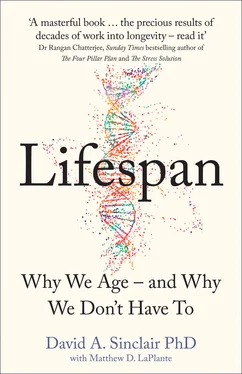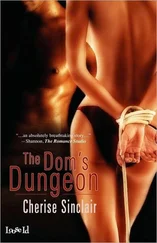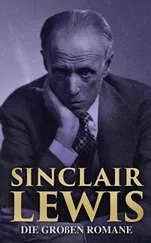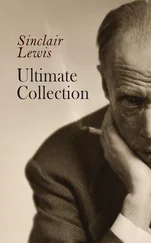They’ve got good evidence for all of this—the entire history of humanity, in fact.
Sure, little by little, millennia by millennia, we’ve been adding years to the average human life, they will say. Most of us didn’t get to 40, and then we did. Most of us didn’t get to 50, and then we did. Most of us didn’t get to 60, and then we did. 12By and large, these increases in life expectancy came as more of us gained access to stable food sources and clean water. And largely the average was pushed upward from the bottom; deaths during infancy and childhood fell, and life expectancy rose. This is the simple math of human mortality.
But although the average kept moving up, the limit did not. As long as we’ve been recording history, we have known of people who have reached their 100th year and who might have lived a few years beyond that mark. But very few reach 110. Almost no one reaches 115.
Our planet has been home to more than 100 billion humans so far. We know of just one, Jeanne Calment of France, who ostensibly lived past the age of 120. Most scientists believe she died in 1997 at the age of 122, although it’s also possible that her daughter replaced her to avoid paying taxes. 13Whether or not she actually made it to that age really doesn’t matter; others have come within a few years of that age but most of us, 99.98 percent to be precise, are dead before 100.
So it certainly makes sense when people say that we might continue to chip away at the average, but we’re not likely to move the limit. They say it’s easy to extend the maximum lifespan of mice or of dogs, but we humans are different. We simply live too long already.
They are wrong.
There’s also a difference between extending life and prolonging vitality. We’re capable of both, but simply keeping people alive—decades after their lives have become defined by pain, disease, frailty, and immobility—is no virtue.
Prolonged vitality—meaning not just more years of life but more active, healthy, and happy ones—is coming. It is coming sooner than most people expect. By the time the children who are born today have reached middle age, Jeanne Calment may not even be on the list of the top 100 oldest people of all time. And by the turn of the next century, a person who is 122 on the day of his or her death may be said to have lived a full, though not particularly long, life. One hundred and twenty years might be not an outlier but an expectation, so much so that we won’t even call it longevity; we will simply call it “life,” and we will look back with sadness on the time in our history in which it was not so.
What’s the upward limit? I don’t think there is one. Many of my colleagues agree. 14There is no biological law that says we must age. 15Those who say there is don’t know what they’re talking about. We’re probably still a long way off from a world in which death is a rarity, but we’re not far from pushing it ever farther into the future.
All of this, in fact, is inevitable. Prolonged healthy lifespans are in sight. Yes, the entire history of humanity suggests otherwise. But the science of lifespan extension in this particular century says that the previous dead ends are poor guides.
It takes radical thinking to even begin to approach what this will mean for our species. Nothing in our billions of years of evolution has prepared us for this, which is why it’s so easy, and even alluring, to believe that it simply cannot be done.
But that’s what people thought about human flight, too—up until the moment someone did it.
Today the Wright brothers are back in their workshop, having successfully flown their gliders down the sand dunes of Kitty Hawk. The world is about to change.
And just as was the case in the days leading up to December 17, 1903, the majority of humanity is oblivious. There was simply no context with which to construct the idea of controlled, powered flight back then, so the idea was fanciful, magical, the stuff of speculative fiction. 16
Then: liftoff. And nothing was ever the same again.
We are at another point of historical inflection. What hitherto seemed magical will become real. It is a time in which humanity will redefine what is possible; a time of ending the inevitable.
Indeed, it is a time in which we will redefine what it means to be human, for this is not just the start of a revolution, it is the start of an evolution.
PART I
WHAT WE KNOW
(THE PAST)
ONE
VIVA PRIMORDIUM
IMAGINE A PLANET ABOUT THE SIZE OF OUR OWN, ABOUT AS FAR FROM ITS STAR,rotating around its axis a bit faster, such that a day lasts about twenty hours. It is covered with a shallow ocean of salty water and has no continents to speak of—just some sporadic chains of basaltic black islands peeking up above the waterline. Its atmosphere does not have the same mix of gases as ours. It is a humid, toxic blanket of nitrogen, methane, and carbon dioxide.
There is no oxygen. There is no life.
Because this planet, our planet as it was 4 billion years ago, is a ruthlessly unforgiving place. Hot and volcanic. Electric. Tumultuous.
But that is about to change. Water is pooling next to warm thermal vents that litter one of the larger islands. Organic molecules cover all surfaces, having ridden in on the backs of meteorites and comets. Sitting on dry, volcanic rock, these molecules will remain just molecules, but when dissolved in pools of warm water, through cycles of wetting and drying at the pools’ edges, a special chemistry takes place. 1As the nucleic acids concentrate, they grow into polymers, the way salt crystals form when a seaside puddle evaporates. These are the world’s first RNA molecules, the predecessors to DNA. When the pond refills, the primitive genetic material becomes encapsulated by fatty acids to form microscopic soap bubbles—the first cell membranes. 2
It doesn’t take long, a week perhaps, before the shallow ponds are covered with a yellow froth of trillions of tiny precursor cells filled with short strands of nucleic acids, which today we call genes.
Most of the protocells are recycled, but some survive and begin to evolve primitive metabolic pathways, until finally the RNA begins to copy itself. That point marks the origin of life. Now that life has formed—as fatty-acid soap bubbles filled with genetic material—they begin to compete for dominance. There simply aren’t enough resources to go around. May the best scum win.
Day in and day out, the microscopic, fragile life-forms begin to evolve into more advanced forms, spreading into rivers and lakes.
Along comes a new threat: a prolonged dry season. The level of the scum-covered lakes has dropped by a few feet during the dry season, but the lakes have always filled up again as the rains returned. But this year, thanks to unusually intense volcanic activity on the other side of the planet, the annual rains don’t fall as they usually do and the clouds pass on by. The lakes dry up completely.
What remains is a thick, yellow crust covering the lake beds. It is an ecosystem defined not by the annual waxing and waning of the waters but by a brutal struggle for survival. And more than that: it is a fight for the future—because the organisms that survive will be the progenitors of every living thing to come: archaea, bacteria, fungi, plants, and animals.
Within this dying mass of cells, each scrapping for and scraping by on the merest minimums of nutrients and moisture, each one doing whatever it can to answer the primal call to reproduce, there is a unique species. Let’s call it Magna superstes . That’s Latin for “great survivor.”
It does not look very different from the other organisms of the day, but M. superstes has a distinct advantage: it has evolved a genetic survival mechanism.
Читать дальше












